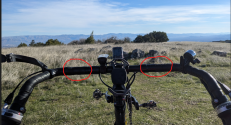I also live in a valley and I can ride along it for 70-80 km with very little elevation. Or I can ride across the sides and as soon as I exit the house I have a 10 min climb at a constant 10% grade, then a eye watering descent with a top speed of 80km/h and then another hill and so on. In a short loop of 20km I can get like 600 meters elevation. I do not dare to take my recumbent on that one, I can't imagine pushing it up at 14.5 kg and also letting loose downhill where it would easily reach 100km/h. So due to my hip injury I rode the recumbent only in the valley but it was becoming so damn boring riding the same route every time.
Maybe the S40 would be indeed better at climbing but I don't understand how they advertise it for short people. I'm 170cm height, 5ft7, and tested a Bachetta with the same seat height, 61-62 cm, and I would barely scratch the floor with my toes. Stopping would mean leaning to one side but then the start was difficult as I was already unbalanced. The v20 has an ideal seat height but maybe too laid back for continous climbing.
Maybe the S40 would be indeed better at climbing but I don't understand how they advertise it for short people. I'm 170cm height, 5ft7, and tested a Bachetta with the same seat height, 61-62 cm, and I would barely scratch the floor with my toes. Stopping would mean leaning to one side but then the start was difficult as I was already unbalanced. The v20 has an ideal seat height but maybe too laid back for continous climbing.




